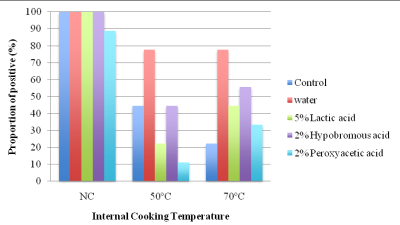Project Summary
Methods for Effectively Controlling E. coli O157:H7 and Salmonella during the Production of Non-intact Beef Products
- Principle Investigator(s):
- YenTe Liao, Chance Brooks, Jennifer Martin, and Mindy Brashears
- Institution(s):
- Texas Tech University
- Completion Date:
- May 2011
Background
Escherichia coli O157:H7 poses a threat to food industries and public health in the United States. Additional strains, including non-O157 Shiga-toxin producing E. coli (STEC), are rapidly becoming microorganisms of concern in fresh meats. Significant interest has been placed on the effectiveness of current microbiological safeguards on the reduction of STECs.
The objectives of this project were to evaluate:
- the efficacy of spray interventions on the reduction of E. coli O157:H7 and non-O157 STEC on the surface of non-intact beef subprimals and mechanically tenderized steaks, and;
- the survivability of E. coli O157:H7 and non-O157 STEC on mechanically tenderized steaks cooked to 50°C or 70°C. Escherichia coli O157:H7 and non-O157 STECs were evaluated separately.
Methodology
USDA Select strip loins (IMPS #180) were divided into two halves and each half assigned to high inoculation (1 × 106 CFU/cm2) or low inoculation (1 × 102 CFU/cm2) using either an E. coli O157:H7 or non-O157 STEC cocktail. Subprimal halves were immersed in their respective inoculation broth for one min and bacteria allowed to attach for 30 min prior to collection of surface swabs (50 cm2).
After attachment, the following spray treatments were applied (25°C) to subprimal halves using a six-nozzle spray cabinet: sterilized water, 5% lactic acid, 2% hypobromous acid, 2% peroxyacetic acid, or control (no treatment). Five min after treatment, lean surface swabs were obtained prior to vacuum storage for 14 d.
After 14 d, lean surface swabs (50 cm2) were obtained from subprimals prior to mechanical tenderization. After tenderization, subprimals were portioned into 2.54-cm steaks. Three steaks from each subprimal were assigned to three targeted internal temperatures: raw (not cooked); 50°C or 70°C. A 50 cm2 swab was obtained from the lean surface of one steak per subprimal prior to cooking and further processing. Steaks were cooked to their targeted internal temperatures on a clam-shell grill.
Internal temperature was monitored throughout cooking and for five min after removal from grill. After five min of rest, an internal (core) sample was aseptically obtained from the center of all steaks for analysis of translocation and survivability at the designated cook temperatures. Swab and core samples were plated on MacConkey’s NT agar (E. coli O157:H7) or POSSE (non-O157 STEC) and incubated at 37°C for 18 to 24 h for enumeration. If enumeration failed to identify colonies, samples were enriched in Difco-GN broth overnight and subjected to IMS and agglutination (E. coli O157:H7) or analysis with the GeneDisc® system.
Findings
Experiment 1: E. coli O157:H7 inoculated (106log CFU/cm2) subprimals, steaks, and cores;
- Spray treatment had an immediate effect (P = 0.0215) on E. coli O157:H7 on beef subprimals.
- After 14 d of storage, a ≥1.6 log CFU/ cm2 reduction was observed on the lean surface of lactic acid, hypobromous acid, and peroxyacetic acid subprimals.
- Core samples from treated samples were positive for E. coli O157:H7 after cooking to either 50 or 70°C. Steaks from lactic acid subprimals were negative for E. coli O157:H7 after cooking to 70°C.
- Spray treatment had no immediate effect (P = 0.2247) on E. coli O157:H7 on beef subprimal surfaces.
- After 14 d, a one log CFU/cm2 reduction in E. coli O157:H7 on subprimal surfaces was observed.
- After cooking to 50°C or 70°C, over 10% of core samples were positive for E. coli O157:H7 in the control, water, and hypobromous acid treatment groups (Figure 1).
- Core samples from peroxyacetic acid treated steaks cooked to 50 or 70°C or lactic acid treated steaks cooked to 70°C were negative for E. coli O157:H7.
Experiment 2: Non-O157 STEC inoculated (106log CFU/cm2) subprimals, steaks, and cores;
- Spray treatment immediately effected (P = 0.1023) surface non-O157 STECs counts.
- Treatment affected non-O157 STEC counts on subprimal surfaces after 14 d of storage (P < 0.0001).
- No treatment differences were observed in non-O157 STECs on steak surfaces.
- Raw and 50°C core samples were 100% for non-O157 STEC, regardless of treatment.
- 88% of core samples from water and hypobromous acid treatments were positive for non-O157 STEC after cooking to 70°C. Core samples from the remaining treatment groups were 100% positive.
- Spray treatment reduced non-O157 STECs immediately after application.
- After 14 d of storage, lactic acid and hypobromous acid treatments had lower non-O157 STEC counts on the subprimal surface. A reduction from d 0 was noted in all treatments.
- Over 88% of steak surfaces were positive for non-O157 STEC after portioning.
- Core samples, regardless of treatment group or cooking temperature, were positive for non-O157 STEC (Figure 2).
Data suggests that that spray treatments (water, 5% lactic acid, 2% hypobromous acid and 2% peroxyacetic acid), with packaging and storage, effectively reduced the target pathogens on subprimal surfaces and in steak cores. The data also suggests non-O157 STECs, compared to E. coli O157:H7 strains, exhibited greater acid and heat tolerance throughout the study.

Figure 1. Proportion of internal steak (core) samples from E. coli O157:H7 inoculated subprimals (102 CFU/cm2) positive for E. coli O157:H7 after cooking to the desired internal temperature (NC - not cooked; 50°C, or 70°C).

Figure 2. Proportion of internal steak (core) samples from non-O157 STEC inoculated subprimals (102 CFU/cm2) positive for non-O157 STEC after cooking to the desired internal temperature (NC - not cooked; 50°C, or 70°C).